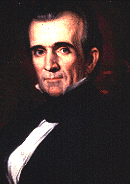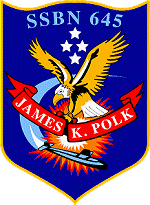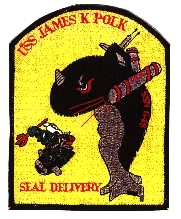 The USS James K. Polk SSBN 645 is named after the 11th President of The United States of America, James Knox Polk, who was born November 2, 1795 in Pineville, Mecklenburg County, North Carolina. His nickname was ‘Young Hickory’. He was elected to the Tennessee House of Representatives in 1823, elected to the U.S. House in 1825 and served there until 1839. While in the House, he served as Speaker from 1835 to 1839. Polk was elected Governor of Tennessee in 1839, and elected President in 1844 (Democratic Party). James K. Polk died on June 15, 1849.
The USS James K. Polk SSBN 645 is named after the 11th President of The United States of America, James Knox Polk, who was born November 2, 1795 in Pineville, Mecklenburg County, North Carolina. His nickname was ‘Young Hickory’. He was elected to the Tennessee House of Representatives in 1823, elected to the U.S. House in 1825 and served there until 1839. While in the House, he served as Speaker from 1835 to 1839. Polk was elected Governor of Tennessee in 1839, and elected President in 1844 (Democratic Party). James K. Polk died on June 15, 1849.
 The burst of sun in the western sky and the eagle in flight symbolize the Spread Eagle Platform, on which James K. Polk campaigned for the presidency to which he was elected in 1844. President Polk sought and achieved territorial expansion to the country’s natural western borders. This vast area, as we know it now, encompasses nine western states of the Union.
The burst of sun in the western sky and the eagle in flight symbolize the Spread Eagle Platform, on which James K. Polk campaigned for the presidency to which he was elected in 1844. President Polk sought and achieved territorial expansion to the country’s natural western borders. This vast area, as we know it now, encompasses nine western states of the Union.
The four stars represent the major land areas acquired during President Polk’s term of office – the California Territory, New Mexico Territory, Texas Statehood, and the Oregon Territory.
The field of blue stands for the unity of purpose among the several states and territories for which Polk strived so hard. Finally, the gold edge surrounding the field of blue reflects the foundation of a formal course of education and preparation for Naval Officers at the United States Naval Academy, founded in 1845.
The Polk Insignia was designed by Ruth McMullen, wife of Commander Frank McMullen, the 1st Blue crew CO.
Statistics:
- Constructed by General Dynamics Electric Boat Division
- Class: Ben Franklin (640)
- Length: 425′
- Beam: 33′
- Displacement (submerged): About 8,250 tons
- Displacement (surfaced): About 7,300 tons
- Submerged Speed: 20+ knots
- Diving depth: Over 800 ft.
- Power Plant: One nuclear reactor, two steam turbines, one shaft
- Crew: 13 Officers, 107 Enlisted
- Armament:
- Up to 16 Poseidon Missiles, each missile is capable of carrying up to 14 W68 Warheads
- Mk48 Torpedoes, four torpedo tubes
| SSBN 645 Commanding Officers | |
| Blue Crew | Gold Crew |
| Commander Frank D. McMullen April 1966 – July 1967 |
Commander Robert M. Douglas April 1966 – April 1968 |
| Commander Peter Durbin July 1967 – May 1971 |
Commander Curtis B. Shellman April 1968 – April 1970 |
| Commander Jerry E. Jones April 1970 – May 1971 |
|
| Poseidon Conversion Commander Jerry E. Jones May 1971 – November 1972 |
|
| Commander Jerry E. Jones November 1972 – June 1974 |
Commander Ernest J. Toupin November 1972 – July 1974 |
| Commander Norman L. Slezak June 1974 – February 1978 |
Commander Richard F. Winter July 1974 – April 1978 |
| Commander Frank M. Conway III February 1978 – June 1981 |
Captain Richard N. Johannes April 1978 – July 1981 |
| Shipyard – Combined Crews Commander Samuel T. Nicholson July 1981 – April 1983 |
|
| Commander Samuel T. Nicholson April 1983 – August 1985 |
Commander W.O. Pool April 1983 – October 1985 |
| Shipyard – Combined Crews Commander Robert C. Love October 1985 – November 1988 |
|
| Commander Robert C. Love November 1988 – May 1989 |
Commander J.D. Reeves November 1988 – September 1991 |
| Commander R.C. Barnes May 1989 – September 1991 |
Commander R.C. Barnes September 1991 – April 1992 |
| SSN 645 Commanding Officers | |
| Commander J.E. Lyons April 1991 – August 1994 |
|
| Commander J.E. Pillsbury August 1994 – April 1997 |
|
| Commander J.E. Johannes, Jr. April 1997 – July 1999 |
|
| Ships Awards |
| • Battle ‘E’, 1980, from SUBRON 16 • Battle ‘E’, 1990, from SUBRON 14 |
| About SSBN/SSN 645 (This information comes from the ships’ “Welcome Aboard” pamphlet) |

The keel for the Navy’s 35th Fleet Ballistic Missile submarine and the first ship of the fleet to be named in honor of James K. Polk was laid at General Dynamics Corporation’s Electric Boat Division at Groton, CT, on November 23, 1963. A year and a half later, this submarine began her water borne career after being christened USS JAMES K. POLK (SSBN-645) by Mrs. Horation Rivero, Jr. on May 22, 1965. For the next 10 months, she underwent fitting-out and on March 13, 1966, she conducted her first sea trials. USS JAMES K. POLK was commissioned as a ship of the U.S. Navy on April 16, 1966.USS JAMES K. POLK combined the almost unlimited endurance of nuclear power with the deterrent might of 16 thermonuclear missiles capable of wreaking more havoc than all the bombs of World War II. These missiles had a range of 2500 nautical miles and were housed in 16 launching tubes located aft of the sail. USS JAMES K. POLK sailed to Charleston, SC in September 1966 to load-out Polaris missiles for her initial deterrent patrol. After completion of the shakedown period, she operated in the Atlantic Ocean and completed 19 strategic deterrent patrols from September 1966 until May 1971. USS JAMES K. POLK conducted her first overhaul at Newport News Shipbuilding and Drydock Company in Virginia for nuclear refueling and conversion of the weapons system to the Poseidon missile system in July 1971. She completed her conversion in late 1972 and commenced a rigorous schedule of sea trials and exercises. These events culminated in the Demonstration and Shakedown Operation (DASO) of the Poseidon missile system. The DASO afforded the opportunity to test the ship’s system, train the crew and launch a Poseidon C-3 missile from the submarine. USS JAMES K. POLK commenced Poseidon deterrent patrols in the Atlantic Ocean in May 1973. She conducted her second overhaul at Portsmouth Naval Shipyard after completing her 50th deterrent patrol in September 1981. The ship completed overhaul in 1983 and conducted 7 more successful patrols. USS JAMES K. POLK returned to Portsmouth Naval Shipyard in January 1986 for a third overhaul after completing her 58th deterrent patrol. She departed Portsmouth Naval Shipyard in November 1988 and sailed south for commencement of her Demonstration and Shakedown Operations (DASO). May 1989 marked the beginning of her final series of Poseidon strategic deterrent patrols. USS JAMES K. POLK celebrated her 25th year of commissioned service in April 1991 and completed her 66th and final strategic deterrent patrol in August of that year. She completed a nineteen month shipyard conversion which removed her 16 Poseidon missiles in March 1994 and converted her designation from SSBN-645 to SSN-645. Since conversion, she has completed two extended deployments to the Mediterranean with Dry Deck shelters and has participated in numerous SPECWAR and NATO exercises. |
The following information has been gathered from various sources, including the Internet and former crewmen. Some of the information may not be entirely accurate.1963
1965
1966
1970
1971
1972
1973
1978
1979
1980
1992
1999
|
|
SSN 645 – New Mission, SPEC OPS |
![[645SDV]](/wp-content/uploads/2017/10/polksdt.gif)   |
SPECIAL OPERATIONS Submarines have long been used for special operations – carrying commandos, reconnaissance teams, and agents on high-risk missions. Most special operations by U.S. submarines are carried out by SEALs, the Sea-Air-Land teams trained for missions behind enemy lines.
These special forces can be inserted by fixed-wing aircraft, helicopter, parachute, or surface craft, but in most scenarios only submarines guarantee covert delivery. Once in the objective area, SEALs can carry out combat search-and-rescue operations, reconnaissance, sabotage, diversionary attacks, monitoring of enemy movements or communications, and a host of other clandestine and often high-risk missions.
Nuclear-powered submarines are especially well-suited for this role because of their high speed, endurance and stealth. U.S. nuclear powered submarines have repeatedly demonstrated the ability to carry out special operations involving many swimmers.
During exercises, which include Army, Air Force, and Marine Corps special operations personnel as well as SEALs, submarines recover personnel who parachute from fixed-wing aircraft and rappel down from helicopters into the sea, take them aboard, and subsequently launch them on missions. These Special Warfare Team Missions include:
-
Combat Swimmer Attacks
-
Reconnaissance and Surveillance
-
Infiltration/Exfiltration Across the Beach
-
Beach Feasibility Studies, Hydrographic Survey, and Surf Observation Teams in support of amphibious landing operations.
Any U.S. submarine can be employed to carry SEALs, however, the Navy has several submarines that have been specially modified to carry swimmers and their equipment more effectively, including the installation of chambers called Dry Deck Shelters (DDSs) to house SEAL Delivery Vehicles (SDVs).
These submarines retain their full suite of weapons and sensors for operations as attack submarines. But they have special fittings, modifications to their air systems and other features to enable them to carry Dry Deck Shelters. The DDS can be used to transport and launch an SDV or to lock out combat swimmers. A DDS can be installed in about 12 hours and is air-transportable, further increasing special operations flexibility.
Several units of the STURGEON (SSN 637) class can carryone chamber each, while two former ballistic missile submarines can accommodate two shelters each. The DDS, fitted aft of the submarine’s sail structure, is connected to the submarine’ after hatch to permit free passage between the submarine and the DDS while the submarine is underwater and approaching the objective area. Then, with the submarine still submerged, the SEALs can exit the DDS and ascend to the surface, bringing with them equipment and rubber rafts, or they can mount an SDV and travel underwater several miles to their objective area.
The number of SEALs carried in a submarine for a special operation varies with the mission, duration, target and other factors. One or more SEAL platoons of two officers and 14 enlisted men are normally embarked, plus additional SEALs to help with mission planning in the submarine and to handle equipment. Former SSBNs employed to operate with SEALs have special berthing spaces for about 50 swimmers.

 The first was a boat out of Holy Loch.”
The first was a boat out of Holy Loch.”